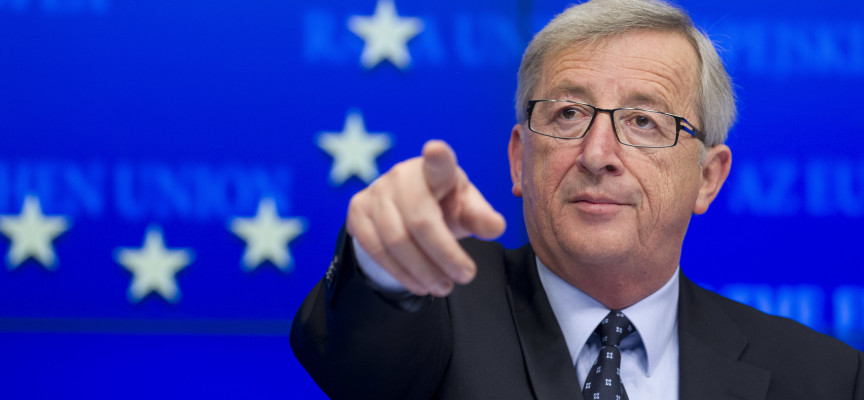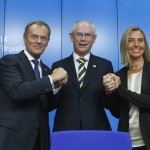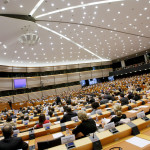The EU Heads of State and Government met in a European Council on 18-19 December in Brussels. They warmly welcomed Jean-Claude Juncker’s plan, which aims to create a ‘European Fund for Strategic Investments’. The mainstream parties of the European Parliament also gave it their resounding approval. It is a positive sign when people are finally talking about investment at European level rather than continuing to lose their way in the murky depths of Eurozone governance. Still, we should remain cautious about the success of this new Fund – for a number of reasons.
Firstly, the declared total of €315bn for this new investment fund is far from being a sure deal. There is no new money for the new fund, given that the European Commission has no mandate to take out capital loans and the Member States have only tiny margins for adjusting their budgets. The fund will be capitalised with just €16bn coming out of the European budget and the rest, €5bn, from the European Investment Bank (EIB).
Secondly, this sum of €21bn of public money would be guaranteeing the tranche with the greatest risk of default for investment projects. After that, private investors will be contributing the capital for the tranches less exposed to risk. By relying on a multiplier effect of 15 between public money and private capital, the European Commission has calculated that the total financing budget could reach €315bn (21 x 115 = 315). This looks more like multiplying loaves of bread, and there are serious doubts that this supposed leverage would actually work. Experience shows that using a multiplier factor such as this one is not realistic for social investment projects or for general infrastructure projects for opening up remote regions. It can be used for projects such as building tolled motorways or for a railway line linking an airport to a city centre.
However, in order to mobilise a fraction of the €15 trillion of private savings in Europe, projects of this kind must be found on the continent of Europe. At the moment there is a preference for investing money elsewhere in the world where the return on investment is higher, or in shares of public debt which are far less subject to risk. It is vital to be cautious here since, due to the lack of an environment that encourages investment, projects such as these are hard to find in Europe nowadays.
That is why Philippe Maystadt, the Belgian former EIB president, has declared that financing will not be the only problem needing to be resolved in order to relaunch investment in Europe. It is also why he is calling for a review of the European regulatory framework, which he would like to see offering greater stimulus to private investment. By that he means, for instance, that more weight should be given to market forces in the infrastructure industries (energy, transport) and there should also be a rejigging of the ‘Solvency II’ package to bring down the costs of long-term investments for insurance companies.
Finally, it remains to be seen whether the Member States will agree to the idea that it will not be them but committees of experts from the EIB and the Commission that will be selecting the projects for this new investment fund from the 2000 proposals already submitted by the Member States. The statement of Jyrki Katainen, Commission Vice-President in charge of the project, that the projects would be “selected according to their merits and without any specific quota by sector or by country” will not be a simple matter to execute.
Whatever happens, the fact that people are once again talking about the future and about investing in Europe is a good sign. We just hope that the new investment fund will be well and truly operational in June 2015.
(source: Europeinfos #178)
I capi di Stato e di governo dell’Unione europea, riuniti il 18-19 dicembre a Bruxelles per un Consiglio europeo, hanno accolto favorevolmente il progetto di Jean-Claude Juncker di creare un “Fondo europeo per gli investimenti strategici”. Allo stesso modo, soddisfazione è stata espressa dai principali gruppi del Parlamento europeo. È infatti positivo che finalmente in ambito europeo si parli di investimenti, invece di continuare a perdersi nei complessi misteri della governance della zona euro. Ma si dovrebbe rimanere cauti circa il successo di questo nuovo fondo, per diverse ragioni.
In primo luogo, perché l’importo annunciato di 315 miliardi di euro per il nuovo fondo è tutt’altro che certo. Per il nuovo fondo non c’è denaro fresco, tenuto conto del fatto che la Commissione non ha il diritto di usare capitali e che gli Stati membri hanno ben poco margine per manovre di bilancio. Il fondo sarà rifornito con soli 16 miliardi di euro dal bilancio dell’UE e cinque miliardi della Banca europea per gli investimenti (BEI).
In secondo luogo, perché questi 21 miliardi di denaro pubblico dovrebbero garantire la fetta dei progetti di investimento a maggiore rischio di insolvenza. Seguirebbero poi gli investitori privati che potrebbero accedere per la tranche meno esposta al rischio. Fidandosi di un effetto moltiplicatore di 15 tra denaro pubblico e capitali privati, la Commissione Europea ha stimato che il pacchetto totale dei finanziamenti potrebbe raggiungere 315 miliardi (21 x 15 = 315). Questo assomiglia un po’ alla moltiplicazione dei pani e sono ammessi seri dubbi sul presunto effetto leva. L’esperienza ha dimostrato che un tale fattore moltiplicatore non è realistico per progetti d’investimento sociali o infrastrutture generali necessari per togliere dall’isolamento aree in ritardo. Si applica per progetti come un’autostrada a pagamento o una linea ferroviaria che collega un aeroporto al centro di una capitale.
Ora, per mobilitare una fetta di 15 miliardi di risparmio privato in Europa, sarà quindi necessario trovare progetti di questo tipo sul nostro continente. Attualmente, il denaro viene invece collocato in altri settori in cui il ritorno sull’investimento è superiore o in titoli del debito pubblico, che hanno un rischio molto più basso. Si richiede quindi prudenza perché a causa della mancanza di un contesto favorevole agli investimenti, questi progetti sono rari oggi in Europa.
Ecco perché l’ex presidente della BEI, il belga Philippe Maystadt ha detto che il finanziamento non sarebbe l’unico problema da risolvere per far ripartire gli investimenti in Europa, e ha proposto di rivedere anche il quadro normativo europeo che egli auspicherebbe più incoraggiante per gli investimenti privati. Con questo egli intende, per esempio, dare più peso alle forze del mercato nelle industrie di rete (energia, trasporti) o ancora uno spostamento del pacchetto “Solvibilità II” per ridurre i costi per investimenti a lungo termine da parte delle compagnie di assicurazione.
Infine, resta da vedere se gli Stati membri accettano l’idea che dei comitati di esperti della BEI e della Commissione scelgano per loro i progetti per questo nuovo fondo a partire dalle 2000 proposte inviate dagli Stati membri. L’annuncio di Jyrki Katainen, vicepresidente della Commissione e responsabile del settore, che i progetti verrebbero “scelti in base al merito intrinseco e senza specifiche quote per settore o paese” non sarà facile da realizzare.
In ogni caso, il fatto di parlare di nuovo di futuro e d’investimenti in Europa, è una buona cosa. Bisogna sperare che il nuovo fondo sia effettivamente operativo nel giugno 2015.
(fonte: Europeinfos #178; traduzione italiana a cura di Eurcom)
Le plan Juncker pour l’investissement
Les chefs d’Etat et de gouvernement de l’Union européenne, réunis les 18-19 décembre à Bruxelles pour un Conseil européen, ont réservé un accueil favorable au plan de Jean-Claude Juncker qui vise à créer un « Fonds européen pour les investissements stratégiques ». De même, les principaux groupes au Parlement européen ont exprimé leur satisfaction. Il est en effet positif que l’on parle enfin d’investissement dans les sphères européennes au lieu de continuer à se perdre dans les arcanes de la gouvernance de la zone euro. Mais il convient de rester prudent quant au succès de ce nouveau Fonds et ceci pour plusieurs raisons.
D’abord parce que le montant annoncé de 315 milliards d’euros pour ce nouveau fonds est loin d’être acquis. Pour le nouveau fonds il n’y a pas d’argent frais compte tenu du fait que la Commission n’a pas le droit d’emprunter des capitaux et que les Etats membres n’ont que très peu de marges de manœuvres budgétaires. Le fonds sera abondé par seulement seize milliards d’euros provenant du budget européen et par cinq milliards de la Banque européenne d’investissement (BEI).
Ensuite parce que cette somme de 21 milliards d’argent public devrait permettre de garantir la tranche du plus grand risque de défaut pour des projets d’investissement. Puis, suivront les investisseurs privés qui pourraient abonder les tranches de risque moins exposées. En misant sur un effet multiplicateur de 15 entre argent public et capitaux privé, la Commission européenne a estimé que le total de l’enveloppe du financement pourrait atteindre 315 milliards (21 x 15 = 315). Cela ressemble un peu à la multiplication des pains et des doutes sérieux sont permis sur l’effet de levier supposé. L’expérience a montré qu’un tel facteur de multiplication n’est pas réaliste pour des projets d’investissements sociaux ou d’infrastructures générales pour désenclaver des régions reculées. Il s’applique pour des projets de type autoroute à péage ou d’une ligne de train reliant un aéroport au centre d’une capitale.
Or, pour mobiliser une fraction de 15.000 milliards d’épargne privée en Europe sur notre continent, il faudra donc trouver des projets de ce type. Actuellement, l’argent est plutôt placé ailleurs dans le monde où le retour sur investissement est supérieur ou dans des titres de dette publique, qui présentent un bien moindre risque. La prudence est donc de mise, car faute d’environnement favorable à l’investissement, ces projets sont aujourd’hui rares en Europe.
C’est pourquoi l’ancien président de la BEI, le Belge Philippe Maystadt a fait savoir que le financement ne serait pas le seul problème à résoudre pour faire repartir l’investissement en Europe et il a proposé de revoir également le cadre règlementaire européen qu’il souhaite plus incitatif pour l’investissement privé. Par cela il entend par exemple de donner plus de poids aux forces de marché dans les industries de réseau (énergie, transport) ou encore un aménagement du paquet ‘Solvabilité II’ pour baisser le coûts pour les placements à long terme par des compagnies d’assurance.
Enfin, il reste à voir si les Etats membres acceptent l’idée que des comités d’experts de la BEI et de la Commission choisissent à leur place les projets pour ce nouveau fonds à partir des 2000 propositions envoyé par les Etats membres. L’annonce de Jyrki Katainen, vice-président de la Commission et en charge du dossier, que les projets seraient « choisis en fonction de leur mérite et sans quota spécifique par secteur ou pays » ne sera pas simple à réaliser.
Quoi qu’il en soit, le fait de parler à nouveau d’avenir et d’investissement en Europe est une bonne chose. Il faut donc espérer que le nouveau fonds sera effectivement opérationnel en juin 2015.
(source: Europeinfos #178)
Junckers Investitionsoffensive
Die Staats- und Regierungschefs der Europäischen Union haben anlässlich des Europäischen Rates vom 18. und 19. Dezember in Brüssel die Pläne von Kommissionspräsident Jean-Claude Juncker zur Einrichtung eines Europäischen Fonds für strategische Investitionen begrüßt. Auch die wichtigsten Fraktionen des Europäischen Parlaments haben Zustimmung signalisiert. Positiv zu vermerken ist in der Tat, dass man sich auf europäischer Ebene endlich dem Thema Investitionen widmet, anstatt sich weiterhin in den Geheimnissen der Governance der Eurozone zu verlieren. Was den Erfolg des neuen Fonds angeht, ist allerdings Vorsicht geboten und dies aus mehreren Gründen.
Zum einen, weil die für diesen neuen Fonds anvisierten Mittel in Höhe von 315 Milliarden Euro noch längst nicht mobilisiert sind. Für den neuen Fonds gibt es kein frisches Geld, da die Kommission nicht befugt ist, Kapital aufzunehmen und die Haushalte der Mitgliedstaaten nur einen geringen Spielraum zulassen. Grundlage des Fonds bildet einzig und allein eine Garantie in Höhe von 16 Milliarden Euro aus dem EU-Haushalt und weitere fünf Milliarden Euro, die von der Europäischen Investitionsbank (EIB)bereitgestellt werden.
Zum anderen, weil mit diesen aus öffentlichen Mitteln stammenden 21 Milliarden Euro die Tranchen mit den größten Ausfallrisiken bei Investitionsprojekten abgesichert werden müssen. Erst dann folgen die Privatinvestoren, die die weniger risikoreichen Tranchen befüllen könnten. Die Kommission rechnet damit, dass der Fonds mittels Hebelwirkung 15-mal so viel privates Kapital und damit Investitionen in einer Gesamthöhe von 315 Milliarden Euro mobilisieren wird (21 x 15 = 315). Dies erinnert ein wenig an die wundersame Brotvermehrung, sodass ernsthafte Zweifel an dieser Rechnung erlaubt sind. Die Erfahrung zeigt, dass ein derartiger Multiplikationsfaktor für soziale Investitionsprojekte bzw. für allgemeine Infrastrukturvorhaben zur besseren Einbindung von Randregionen unrealistisch ist. Besser geeignet ist er für Vorhaben vom Typ Mautautobahn oder für den Bau einer Schienentrasse zur Anbindung eines Flughafens an das Stadtzentrum.
Um aber die Europäer dazu zu bewegen, auch nur einen Bruchteil ihrer privaten Ersparnisse in einer Gesamthöhe von 15.000 Milliarden in Europa zu investieren, müssen genau solche Projekte aufgetan werden. Derzeit wird das Geld eher anderswo in der Welt investiert, wo die Investitionsrendite höher sind, oder aber es wird in öffentlichen Schuldverschreibungen angelegt, die ein wesentliches geringeres Risiko aufweisen. Es ist also Vorsicht geboten, denn in Ermangelung günstiger Rahmenbedingungen sind diese Vorhaben in Europa dünn gesät.
Vor diesem Hintergrund hat der ehemalige EIB-Präsident Phillipe Maystadt darauf hingewiesen, die Finanzierung sei nicht das einzige Problem, das es zu lösen gelte, um die Investitionen in Europa anzukurbeln. Er schlägt daher zusätzlich eine Überarbeitung des europäischen Rechtsrahmens vor, damit dieser mehr Anreize für Privatinvestitionen bietet. In diesem Zusammenhang plant er beispielsweise eine Stärkung der Marktkräfte im Bereich der Netzwerkindustrien (Energie, Transport) oder aber eine Anpassung des Pakets „Solvabilität II“ mit dem Ziel, die Kosten für langfristige Anlagen von Versicherungsunternehmen zu senken.
Schließlich bleibt abzuwarten, ob die Mitgliedstaaten sich mit dem Gedanken anfreunden können, dass Expertenausschüsse der EIB und die Europäische Kommission auf der Grundlage von 2000 von den Mitgliedstaaten eingereichten Vorschlägen an ihrer Stelle über die Projekte für diesen neuen Fonds entscheiden. Die Ankündigung des mit dieser Angelegenheit betrauten Vizepräsidenten der Europäischen Kommission, Jyrki Katainen, die Vorhaben würden „auf der Grundlage ihres Verdienstes und nicht quotenspezifisch nach Sektor oder Land ausgewählt“, wird nicht einfach umzusetzen sein.
Wie dem auch sei, allein die Tatsache, dass in Europa wieder über Zukunft und Investitionen gesprochen wird, ist bereits eine gute Sache. Es bleibt zu hoffen, dass der neue Fonds im Juni 2015 wirklich einsatzbereit sein wird.
(quelle: Europeinfos #178)
Stefan Lunte
Latest posts by Stefan Lunte (see all)
- Justice & Peace Europe’s Concerted Action 2017 - 14 marzo 2017
- The relaunch of a common security and defence policy - 24 settembre 2015
- Juncker’s plan for kick-starting investment - 8 gennaio 2015











